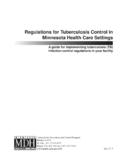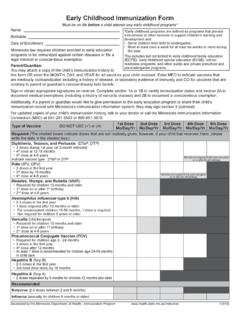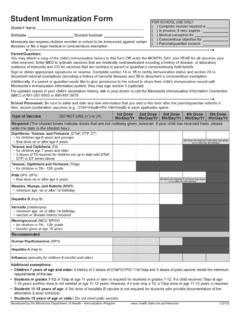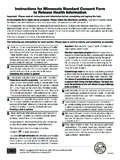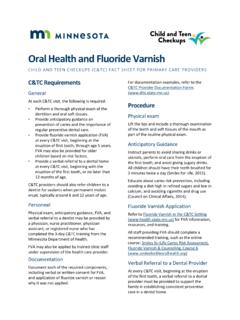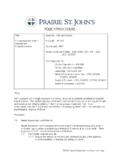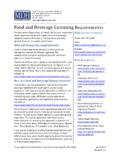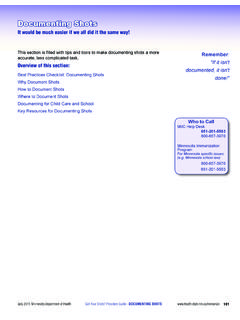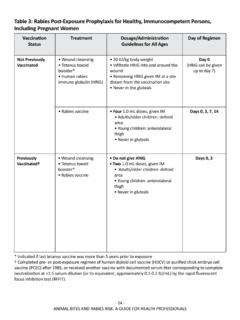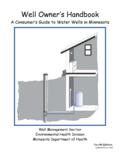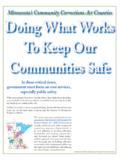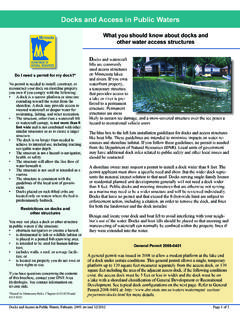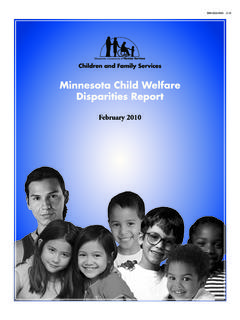Transcription of Public Health Interventions - Minnesota Department of Health
1 Public Health Interventions Applications for Public Health Nursing Practice March 2001 Minnesota Department of Health Division of Community Health Services Public Health Nursing Section Public HealthInterventionsApplications for Public HealthNursing PracticeMarch 2001 Public Health Nursing Practice for the 21st Century Project Director: Mary Rippke, RN, MAProject Coordinator: Laurel Briske, RN, MA, CPNPP roject Staff: Linda Olson Keller, RN, MS, CS, and Sue Strohschein, RN, MSAdministrative Assistant: Jill SimonettiDevelopment of this document was supported by federal grant 6 D10 HP 30392, Divisionof Nursing, Bureau of Health Professions, Health Resources and Service Administration,United States Department of Health and Human Services.
2 Minnesota Department of HealthDivision of Community Health ServicesPublic Health Nursing SectionAcknowledgmentsPublic Health Interventions : Applications for Public Health Nursing Practiceacknowledges the tremendous contribution made by practicing Public Health nurses (PHNs)and educators from Iowa, Minnesota , North Dakota, South Dakota, and Wisconsin. Specialthanks go to the graduate students who identified and analyzed relevant intervention literature. Forty-six practice experts and educators from those same states volunteered to serve on reviewpanels, devoting hours of their time and, more importantly, their practice wisdom. An additional150 preceptors and participants from the Public Health Nursing Practice for the 21stCentury project provided invaluable input for clarification and richness of the content.
3 Thisdocument could not have happened without them. Gratitude also goes to LaVohn Josten andSharon Cross, School of Nursing, University of Minnesota for their insight and Interventions also reflect the talents and skills of many Minnesota Department of Healthstaff. In particular we want to acknowledge our colleagues in the Section of Public HealthNursing, Marie Margitan, Terre St. Onge, and Karen Zilliox; Diane Jordan and the libraryservices staff; and Lisa Patenaude, former administrative are interested in learning more about how the model is being used or adapted. If you havecomments or questions, please contact Olson citation: Public Health Nursing Section: Public Health Interventions Applications for PublicHealth Nursing Practice.
4 St. Paul: Minnesota Department of Health , Search ManagersMary Jo Chippendale, University of MinnesotaJennifer Deschaine, Bethel CollegeKathy Lammers, Winona State UniversityDeborah Meade, Augsburg CollegeJackie Meyer, University of IowaDolores Severtson, University of Wisconsin-MadisonVictoria Von Sadovszky, University of Wisconsin-MadisonExpert PanelistsIowaElaine Boes, Palo Alto County Community Health ServiceNancy Faber, Worth County Public HealthMarti Franc, Des Moines Visiting Nurse ServicesPenny Leake, Winneshiek County Public HealthTherese O Brien, Lee County Health DepartmentJanet Peterson, Iowa Department of HealthJane Schadle, Wellmark Community Health ImprovementLu Sheehy, Skill Medical CenterJenny Terrill, Iowa Department of HealthMinnesota Mary Kay Haas, Minnesota Nurses AssociationBonnie Brueshoff, Dakota County Public HealthTerre St.
5 Onge, Minnesota Department of HealthJean Rainbow, Minnesota Department of HealthKaren Zilliox, Minnesota Department of HealthBarb Mathees, Minnesota State University-MoorheadCecilia Erickson, Minneapolis Public SchoolsAne Rogers, Cass County Public HealthRose Jost, Bloomington Health DepartmentDorothea Tesch, Minnesota Department of HealthNancy Vandenberg, Minnesota Department of HealthAnn Moorhous, Minnesota Department of HealthMary Sheehan, Minnesota Department of HealthPenny Hatcher, Minnesota Department of HealthNorth DakotaRuth Bachmeier, Fargo Cass Public HealthNancy Mosbaek, Minot State UniversityCheryl Hagen, Fargo Cass Public HealthKelly Schmidt, First District Health Unit MinotDebbie Swanson, Grand Forks Public Health DepartmentBarb Andrist, Upper Missouri District Health UnitSouth DakotaNancy Fahrenwald, South Dakota State UniversityDarlene Bergeleen, South Dakota Department of HealthJoan Frerichs, Grant County MilbankPaula Gibson, South Dakota Department of HealthWisconsinJudy Aubey, Madison Department of Public HealthElizabeth Giese, Division of Public Health -WisconsinBarbara Nelson, St.
6 Croix Health & Human Services DepartmentTim Ringhand, Chippewa County Department of Public HealthMarion Reali, Eau Claire City/County Health DepartmentGretchen Sampson, Polk County Health DepartmentVicki Moss, Viterbo CollegeJoan Theurer, Wisconsin Department of Health & Family ServicesJulie Willems Van Dijk, Marathon County Health DepartmentSection of Public Health NursingPublic Health Minnesota Department of Health Interventions1 Public Health Nursing InterventionsPublic Health nurses (PHNs) work in schools, homes, clinics, jails, shelters, out of mobile vans and dog sleds. They work with communities, the individuals and families that compose communities, and the systems thatimpact the Health of those communities.
7 Regardless of where PHNs work or whom they work with, all publichealth nurses use a core set of Interventions to accomplish their are actions that PHNs take on behalf of individuals, families, systems, and communities to improve or protect Health framework, known as the intervention model, defines the scope of Public Health nursing practice by typeof intervention and level of practice (systems, community, individual/family), rather than by the more traditional site of service, that is, home visiting nurse, school nurse, occupational Health nurse, clinic nurse, etc. Theintervention model describes the scope of practice by what is similar across settings and describes the work ofpublic Health nursing at the community and systems practice levels as well as the conventional individual/familylevel.
8 These Interventions are not exclusive to Public Health nursing as they are also used by other Public healthdisciplines. The Public Health intervention model does represent Public Health nursing as a specialty practice ofnursing. (See The Cornerstones of Public Health Nursing, Appendix A)An enlarged black and white copy of the wheel can be found in Appendix , C. A., Highriter, M. E. (1978). Community Health nursing population and practice. Public HealthReviews, 7(4), of Public Health NursingPublic Health Minnesota Department of Health Interventions2 The Intervention WheelThe model, or the intervention wheel, as it has come to be known, integrates three distinct and equallyimportant population-basis of all Public Health three levels of Public Health practice: 17 Public Health Interventions .
9 SurveillanceDisease and Health Threat InvestigationOutreach ScreeningCase-FindingReferral and Follow-upCase ManagementDelegated FunctionsHealth TeachingCounseling ConsultationCollaborationCoalition BuildingCommunity organizingAdvocacySocial MarketingPolicy Development and EnforcementThe model itself consists of a darkened outside ring, three inner rings and seventeen slices. Each of the innerrings of the model are labeled population-based, indicating that all Public Health Interventions are population-based. A population is a collection of individuals who have one or more personal or environmentalcharacteristics in A population-of-interest is a population that is essentially healthy, but who couldimprove factors that promote or protect Health .
10 A population-at-risk is a population with a common identified riskfactor or risk-exposure that poses a threat to Health Interventions are population-based if they focus on entire populations possessingsimilar Health concerns or means focusing on everyone actually or potentially impacted by the condition or who share asimilar characteristic. Population-based Interventions are not limited to only those who seek service orwho are poor or otherwise vulnerable. Population-based planning always begins by identifying 2 Population-based practice assessment, planning and evaluation model. (1999). CHS planning Department of Health (attached as an Appendix).
